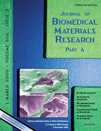Stereo imaging and cytocompatibility of a model dental implant surface formed by direct laser fabrication
Abstract
Direct laser fabrication (DLF) allows solids with complex geometry to be produced by sintering metal powder particles in a focused laser beam. In this study, 10 Ti6Al4V alloy model dental root implants were obtained by DLF, and surface characterization was carried out using stereo scanning electron microscopy to produce 3D reconstructions. The surfaces were extremely irregular, with ∼100 μm deep, narrow intercommunicating crevices, shallow depressions and deep, rounded pits of widely variable shape and size, showing ample scope for interlocking with the host bone. Roughness parameters were as follows: Rt, 360.8 μm; Rz, 358.4 μm; Ra, 67.4 μm; and Rq, 78.0 μm. Disc specimens produced by DLF with an identically prepared surface were used for biocompatibility studies with rat calvarial osteoblasts: After 9 days, cells had attached and spread on the DLF surface, spanning across the crevices, and voids. Cell density was similar to that on a commercial rough microtextured surface but lower than on commercial smooth machined and smooth-textured grit-blasted, acid-etched surfaces. Human fibrin clot extension on the DLF surface was slightly improved by inorganic acid etching to increase the microroughness. With further refinements, DLF could be an economical means of manufacturing implants from titanium alloys. © 2008 Wiley Periodicals, Inc. J Biomed Mater Res, 2009




